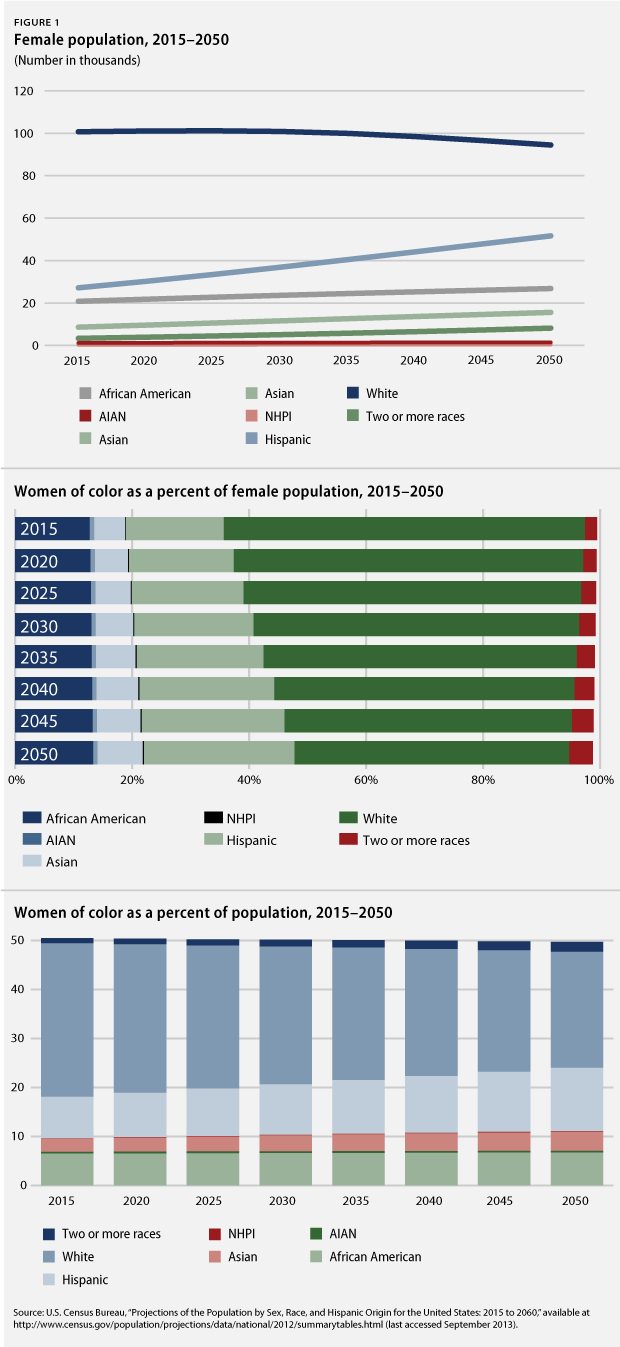Throughout the 20th century, women fought for and achieved countless victories for women’s rights and became a political and economic force in our society after winning the right to vote, equal pay, and reproductive rights. While women have continued to organize for collective gains into the 21st century, the benefits of those achievements have not been equally shared. Over time, those gaps have expanded into wide and deep inequalities for some women—namely, women of color.
Despite making meaningful gains in education and entrepreneurship, women of color face unique challenges, especially in regards to their economic security. This is profoundly troubling given our nation’s changing demographics and the fact that women of color will make up 53 percent of the population by 2050. Hispanic women will lead this growth, increasing from a share of 16.7 percent of the female population in 2015 to 25.7 percent in 2050. Asian women’s share of the female population will similarly grow by 80 percent, from 5.3 percent in 2015 to 7.8 percent in 2050. African American women’s share of the female population will grow from 12.8 percent to 13.3 percent during the same time period. The share of women who identify with two or more races will also grow, increasing from 2.1 percent in 2015 to 4.1 percent in 2050. White women, however, will drop from 61.8 percent of the female population in 2015 to 47 percent in 2050. (see Figure 1)

Women of color will comprise the majority of all women in the future, and it is in our best interest to close racial gaps so we can begin to create a society and workforce that will sustain U.S. competitiveness on the global stage.
The Affordable Care Act, or ACA, is an example of what can be done to address the challenges that women of color face. This law has the potential to improve the disproportionately poor health of women of color through better access to affordable health insurance and health services. Improved health can increase the livelihood of women of color as poor health can impact one’s ability to work or attain an education and thus affects an individual’s and a family’s economic security. Healthier people contribute to a robust workforce, which, in turn, strengthens the economy.
Women of color are vital to the economic future of the United States as they become a greater share of the workforce. They will need to be much better prepared than they are today, with more educational and training opportunities that will ensure that the United States can fill the high-impact jobs that it seeks to create. Today, women of color lag behind both white women and their male counterparts in a number of indicators that gauge their economic security. These inequalities not only put individuals and families at risk, but they also put the health of our economy at risk by creating an unprepared workforce and reducing the people’s purchasing power.
Moreover, while many conversations in the mainstream media suggest that women of color are a monolithic entity, it is important to note that women of color are a diverse group with a variety of experiences. We acknowledge the limitations of this report and understand that the data in this report do not address differences that may exist for lesbian, gay, bisexual, and transgender, or LGBT, women of color and other groups of women of color who experience additional challenges.
This report examines the current state of women of color in the United States across various indicators of prosperity, given trends over the past two decades. The report also focuses on recent changes from the start of the Great Recession in 2007 through the recovery, which began in June 2009, to the present day. Where available, we offer specific data points on various racial and ethnic groups as we present the issues of greatest importance to women of color in the following key areas:
- Economic security
- Poverty
- Health
- Educational attainment
- Political leadership
- Entrepreneurship
This report also seeks to describe the landscape for women of color, including the economic and health insecurities they face, as well as the progress that has been made in areas such as education and entrepreneurship. In the final section of the report, we present policy opportunities that exist to improve the lives of women of color and, in turn, strengthen the U.S. economy so that everyone can benefit from the country’s prosperity.
Farah Ahmad is a Policy Analyst for Progress 2050 at the Center for American Progress. Sarah Iverson is a former intern with Progress 2050.